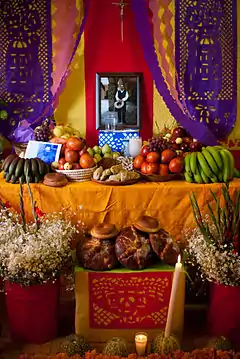Ofrenda
An ofrenda (Spanish: "offering") is a home altar with a collection of objects placed on a ritual display during the annual and traditionally Mexican Día de Muertos celebration. An ofrenda, which may be quite large and elaborate, is usually created for an individual person who has died and is intended to welcome them to the altar setting.
| Look up ofrenda in Wiktionary, the free dictionary. |

Background
This display coincides with the Día de Muertos, which is a tradition originating with the Aztecs.[1] The Aztec culture considered souls to continuously live and enter different realms when a body would die. This view the Aztecs held was commingled with the Christian beliefs that the soul is eternal (whether it be in heaven, purgatory, or hell) during the Spanish conquest of the Aztec Empire when the two cultures were merged. The ofrenda is presented in one's home in order to commemorate the souls of loved ones in the family.
Components of the offering
A common format for an ofrenda contains three levels or tiers. The topmost tier identifies the dead person who is being invited to the altar, frequently with photos of the deceased, along with images of various saints, statuettes of the Virgin Mary, crucifixes, etc. which are positioned in a retablo which forms the back of the altar;[2] on the second tier are things placed to encourage the dead to feel at home and welcome: the deceased person's favorite food items might go here, including such things as mole, candy, pan dulce, and especially a sweet bread called pan de muerto. For deceased adults, the ofrenda might include a bottle or poured shot glasses of tequila or mezcal, while if the deceased is a child a favorite toy might be placed here. The bottom-most tier almost always contains lit candles, and might also have a washbasin, mirror, soap, and a towel so that the spirit of the deceased can see and refresh themselves upon arrival at the altar. Throughout the altar are placed calaveras (decorated candied skulls made from compressed sugar) and bright orange and yellow marigolds (cempazuchitl), an Aztec flower of the dead. Ofrendas are constructed in the home as well as in village cemeteries and churches.[3][4]
The ofrenda typically features types of decorations that are representative of the four elements.[5] For example, candles are lit on the table to symbolize the element of fire. Incense from the resin of copal trees are also used in the offering in order to produce smells that will scare away evil spirits.[1]
In culture
A non-fiction children's book called Day of the Dead: A Mexican-American Celebration was written by Diane Hoyt-Goldsmith.[6] The book is about a Mexican-American family celebrating the Day of the Dead (Día de Muertos) in California and is focused on two young twins in the family. The twins help the family create an ofrenda for their loved ones, as well as a larger ofrenda for their community.[6]
An ofrenda forms a central plot theme in the 2017 animated film Coco.[7]
In Season 15 of Grey’s Anatomy, the family of a patient build an ofrenda in her hospital room to mark the Día de los Muertos. The episode contains several other references to the holiday, including many of the doctors meditating on dead loved ones and multiple appearances of marigolds.[8]
In the 1998 PC adventure game Grim Fandango, which is set in the Land of the Dead during the Day of the Dead, one of the supporting characters is named Olivia Ofrenda. The game is also largely based around Mexican folklore and traditions such as the Día de los Muertos, as well as some Aztec mythology.
References
- Scalora, Salvatore (1995). "Celebrating the spirits' return". Americas (English Edition): 32(10).
- Davíd Carrasco; Scott Sessions (31 July 2011). Daily Life of the Aztecs. ABC-CLIO. p. 251. ISBN 978-0-313-37744-0.
- Kenneth L. Untiedt (2008). Death Lore: Texas Rituals, Superstitions, and Legends of the Hereafter. University of North Texas. p. 149. ISBN 978-1-57441-256-7.
- Maria Herrera-Sobek (31 July 2012). Celebrating Latino Folklore. ABC-CLIO. p. 406. ISBN 978-0-313-34340-7.
- Mack, Stevie; Williams, Kathleen (2010). "Commemorating the Ancestors". SchoolArts: The Art Education Magazine for Teachers. 110 (2): 21–23.
- Hoyt-Goldsmith, Diane. Day of the dead : a Mexican-American celebration. Migdale, Lawrence, Holiday House (Firm) (First ed.). New York. ISBN 0823410943. OCLC 29522859.
- https://screenrant.com/coco-pixar-ofrenda-explained-details/
- https://wearemitu.com/entertainment/greys-anatomy-celebrated-dia-de-los-muertos/
